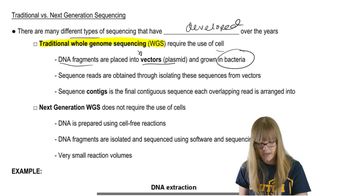Table of contents
- 1. Introduction to Genetics51m
- 2. Mendel's Laws of Inheritance3h 37m
- 3. Extensions to Mendelian Inheritance2h 41m
- 4. Genetic Mapping and Linkage2h 28m
- 5. Genetics of Bacteria and Viruses1h 21m
- 6. Chromosomal Variation1h 48m
- 7. DNA and Chromosome Structure56m
- 8. DNA Replication1h 10m
- 9. Mitosis and Meiosis1h 34m
- 10. Transcription1h 0m
- 11. Translation58m
- 12. Gene Regulation in Prokaryotes1h 19m
- 13. Gene Regulation in Eukaryotes44m
- 14. Genetic Control of Development44m
- 15. Genomes and Genomics1h 50m
- 16. Transposable Elements47m
- 17. Mutation, Repair, and Recombination1h 6m
- 18. Molecular Genetic Tools19m
- 19. Cancer Genetics29m
- 20. Quantitative Genetics1h 26m
- 21. Population Genetics50m
- 22. Evolutionary Genetics29m
15. Genomes and Genomics
Sequencing the Genome
Problem 25b
Textbook Question
Whole-exome sequencing (WES) is helping physicians diagnose a genetic condition that has defied diagnosis by traditional means. The implication here is that exons in the nuclear genome are sequenced in the hopes that, by comparison with the genomes of nonaffected individuals, a diagnosis might be revealed.
What are the strengths and weaknesses of this approach?
 Verified step by step guidance
Verified step by step guidance1
<span>**Step 1:** Understand the concept of Whole-Exome Sequencing (WES). WES is a technique that sequences all the protein-coding regions (exons) of genes in a genome. These regions are crucial because they are where most known disease-causing mutations occur.</span>
<span>**Step 2:** Identify the strengths of WES. One major strength is its efficiency and cost-effectiveness compared to whole-genome sequencing, as it focuses only on exons, which constitute about 1-2% of the genome but contain approximately 85% of known disease-related variants.</span>
<span>**Step 3:** Consider the diagnostic power of WES. By comparing the exome of an affected individual with those of nonaffected individuals, it can help identify genetic variants that may be responsible for a condition, especially when traditional diagnostic methods have failed.</span>
<span>**Step 4:** Examine the weaknesses of WES. One limitation is that it does not capture non-coding regions of the genome, which can also play significant roles in gene regulation and disease. Additionally, WES may miss structural variants or large deletions that affect multiple exons.</span>
<span>**Step 5:** Reflect on the interpretation challenges. Even when variants are identified, determining their clinical significance can be complex, requiring further functional studies and validation to confirm their role in the disease.</span>
Recommended similar problem, with video answer:
 Verified Solution
Verified SolutionThis video solution was recommended by our tutors as helpful for the problem above
Video duration:
1mPlay a video:
Was this helpful?
Key Concepts
Here are the essential concepts you must grasp in order to answer the question correctly.
Whole-Exome Sequencing (WES)
Whole-exome sequencing (WES) is a genomic technique that focuses on sequencing all the protein-coding regions, or exons, of the genome. These exons represent about 1-2% of the entire genome but contain approximately 85% of known disease-related variants. WES is particularly useful for identifying genetic mutations associated with various conditions, making it a powerful tool in clinical diagnostics.
Recommended video:
Guided course

Sequencing Overview
Comparative Genomics
Comparative genomics involves comparing the genomic data of affected individuals with that of nonaffected individuals to identify genetic variations that may contribute to disease. This approach helps in pinpointing mutations that are likely pathogenic, as it highlights differences that could be responsible for the observed condition. It is essential for interpreting WES results and understanding the genetic basis of diseases.
Recommended video:
Guided course

Genomics Overview
Strengths and Weaknesses of WES
The strengths of WES include its ability to uncover rare genetic variants and its efficiency in diagnosing complex genetic disorders that traditional methods may miss. However, its weaknesses involve the potential for incidental findings, the challenge of interpreting variants of uncertain significance, and the fact that WES does not capture non-coding regions or structural variants, which can also play critical roles in genetic diseases.
Recommended video:
Guided course

Prokaryotic Transcription

 8:55m
8:55mWatch next
Master Sequencing Overview with a bite sized video explanation from Kylia Goodner
Start learning



